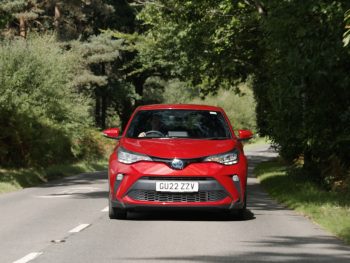Toyota’s hybrid car driving tips for best fuel economy
Toyota has published some top tips to help drivers get the most out of their hybrid cars, improving fuel consumption, so they can travel further for less.

Toyota’s tips can help drivers get the most out of their hybrid cars
As the cost of living continues to increase and drivers face high fuel prices, the carmaker has released a new short film with TV presenter Grace Webb explaining the Toyota Hybrid driving tips for best fuel economy.
- Its first seven tips apply to conventional petrol and diesels too:
- Clear out the boot! Keeping it free of unnecessary weight will give your car an immediate boost in performance and economy.
- For optimum performance, check your tyre pressures – do a weekly check to ensure that your tyres are inflated in line with the manufacturer’s recommendation. An easy online check will give you the right figures for your model.
- Think ahead. By planning your journeys, you can avoid periods of heavy traffic, and minimise the risk of using up fuel while sitting in jams or getting lost.
- Shut up! Closing the windows and sunroof at speeds above 45mph will reduce drag and cut your fuel consumption.
- Similarly, remove roof racks, boxes and bike racks when not in use – they’re a real drag too!
- Steady as she goes – maintain a steady speed and don’t go over the speed limit.
- Smoothly does it! Try to avoid sudden braking or acceleration.
Specific driving tips for full hybrids:
- Become familiar with your car’s hybrid information display to fully understand the system, see how much energy is being used, and manage the charge levels in the high-voltage battery.
- Harvest time – every time you brake or your car slows down, energy is captured that’s converted into electricity and boosts the charge in the battery. Smooth and gentle braking means more power for the car to run on electric power with zero fuel consumption.
- If you’re in stop-start traffic, don’t put the car in neutral (‘N’) when stationary, as electricity will not be generated, and the hybrid battery will use up its charge.
- Consider using the cruise control to maintain steady speeds.
- When using climate control, remember that the ‘recirculate’ mode reduces the draw on the car’s battery.
- Think about the environment. Constant or heavy use of systems such as air-con, lights and wipers, will increase energy consumption.
- If you’re driving a Toyota hybrid, you will have the choice of four drive modes: Normal, EV, Eco and Power. When you first start your car, it defaults to the ‘Normal’ mode, which automatically manages the most efficient use of both the engine and the battery. You can select a different mode to achieve better fuel consumption in certain settings. For example, in EV mode the car is powered by the battery alone during city driving, running almost silently and with no tailpipe emissions for as long as the level of battery charge permits. Eco mode reduces the air conditioning system’s output and adjusts throttle response to limit harsh acceleration; and Power mode boosts acceleration by using the hybrid battery to assist the petrol engine.
- Use the car’s battery power whenever possible. For example, when driving in towns, accelerate to your required speed, then ease off the accelerator and then gently ease the accelerator on again. This should activate EV mode – indicated by a green light in the instrument display on a Toyota hybrid. This shows that the engine has switched off and you are using just the car’s electric motor.
- Try to maintain a constant speed by reading the road ahead, reducing unnecessary braking and acceleration and thus using less fuel. Braking slowly and gently also maximises the amount of energy recovered by the car’s regenerative braking system.
- If you have a Toyota and use the MyT app, you can use the hybrid coaching function to check out your driving at the end of each trip, so you can improve on your scores next time.
The carmaker also highlights other factors to consider:
- Bear in mind that many factors can affect a car’s performance, whether it’s a hybrid or not. On cold days your car will use more fuel as it warms up, but once it’s reached its optimum temperature, the mpg figures will increase
- Also, in winter, you’re more likely to be using the air conditioning, lights and wipers, all of which will consume electricity from the battery. If you regularly travel the same route, don’t be surprised if you achieve better fuel figures during the summer than in winter.
- Drivers are also reminded to drive safely at all times and adhere to the rules of the road.
For more of the latest industry news, click here.

